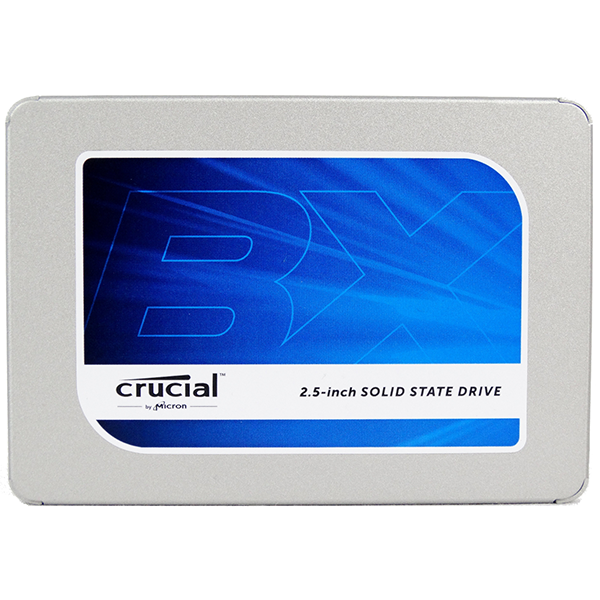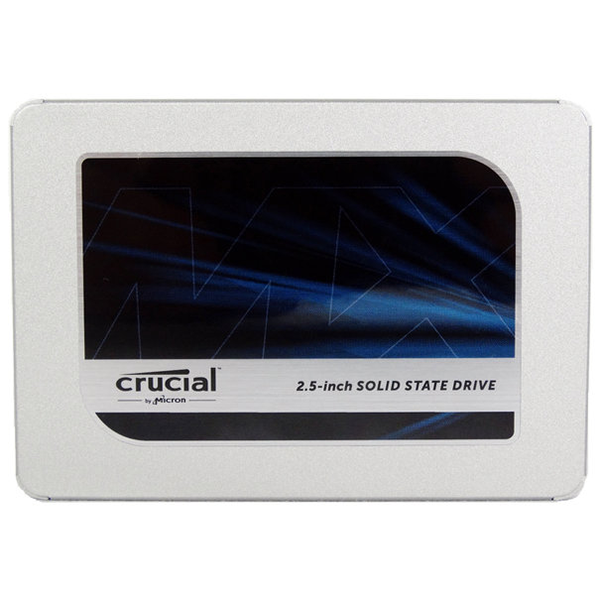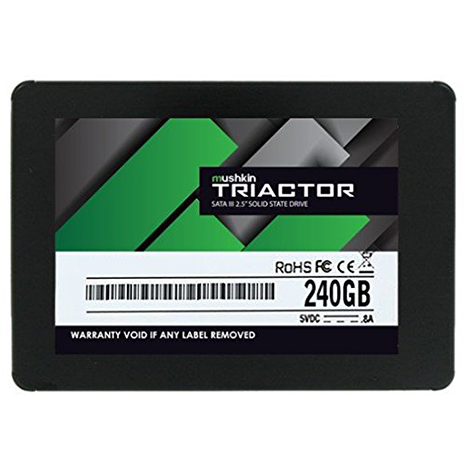The 860 EVO Review: Samsung Back On Top
The world's best selling SSD just got a makeover.
Why you can trust Tom's Hardware
Comparison Products
256GB-class products are still very popular even though many enthusiasts have moved on to larger models. These drives often cost only a little more than 128GB products and have a much lower dollar-per-GB ratio.
We have the Samsung 860 EVO and Crucial MX500 in this group. This is the first article with the 250GB MX500, but we plan to update the Crucial review with every capacity. The Samsung 850 EVO and Pro were a dominant force in this capacity class for several years. The Crucial BX300, Mushkin Triactor, and Toshiba VX500 round out the list.
Many of these products use just eight 256Gbit die (32GB). These SSDs will show the most performance variation because they only have a few die.
Sequential Read Performance
To read about our storage tests in-depth, please check out How We Test HDDs And SSDs. We cover four-corner testing on page six of our How We Test guide.

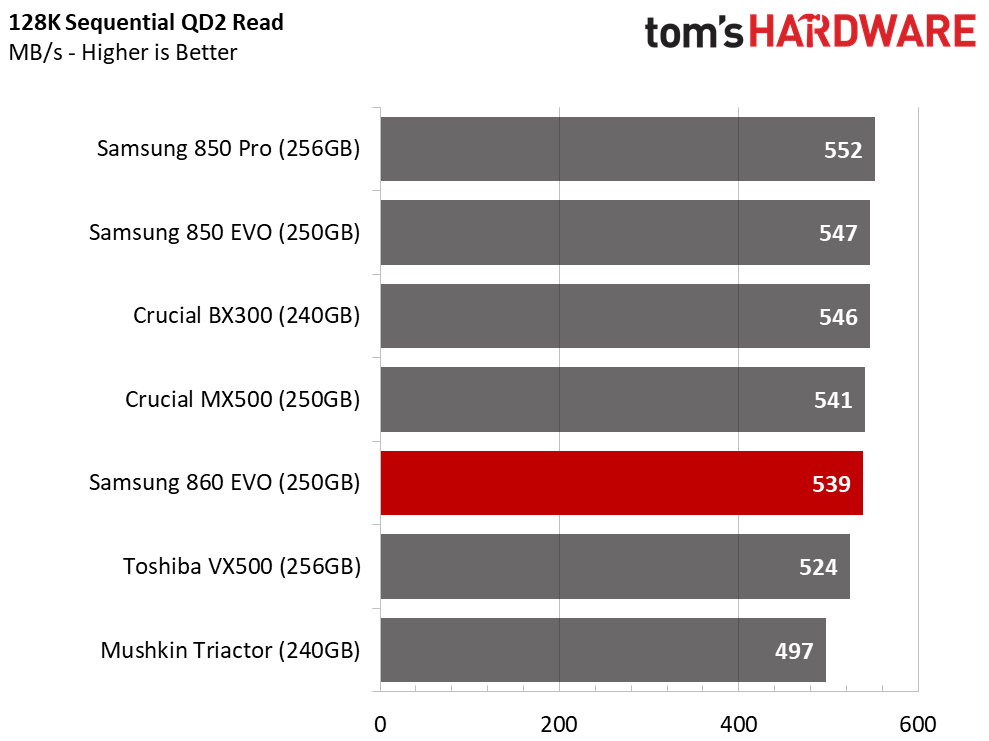
We observed a slight change between the three 860 EVO SSDs at QD2. The 1TB reached 545 MB/s, the 500GB reached 541MB/s, and the 250GB turns in 539MB/s. None of the 860 EVOs took the top spot, but all the drives are similar.
Sequential Write Performance
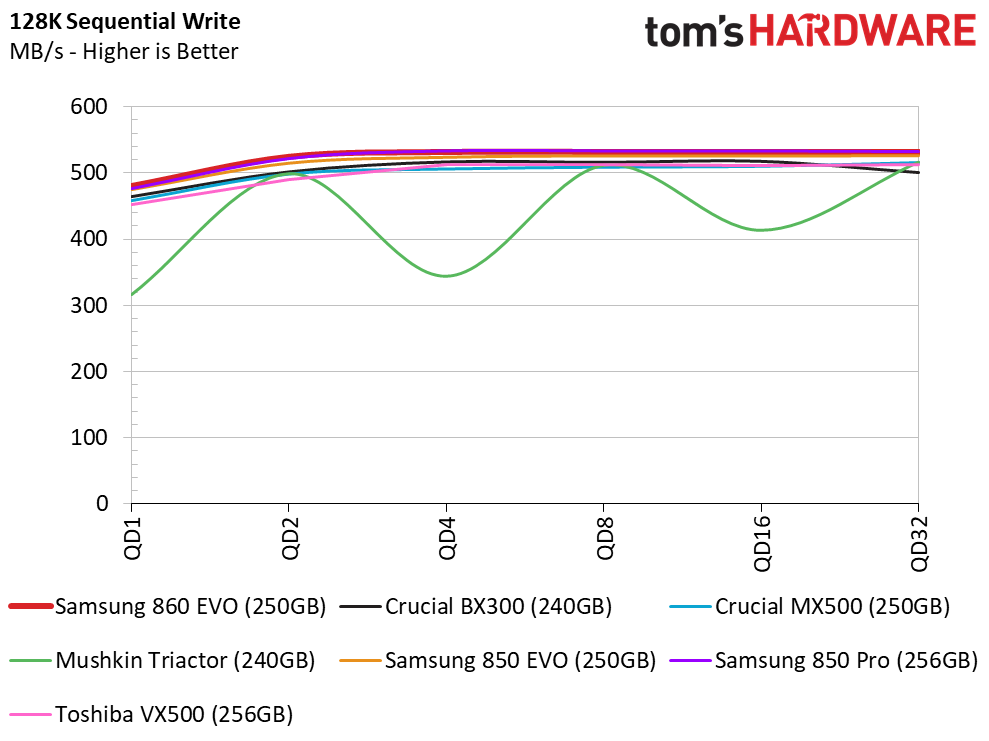
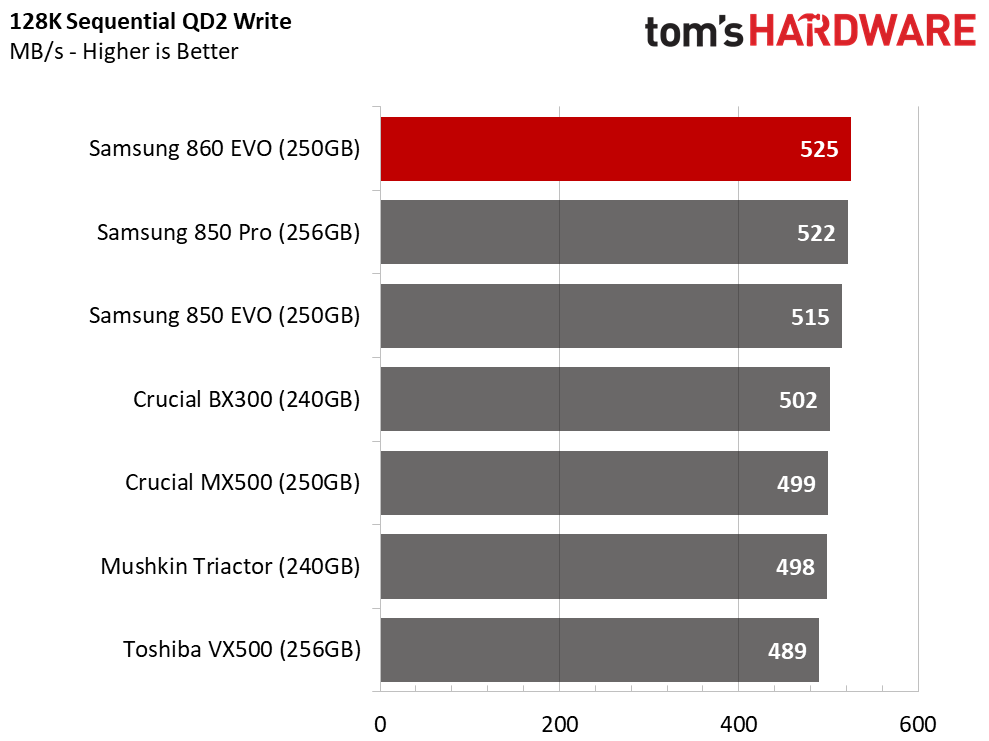
The 860 EVO leads the sequential write tests. Samsung's impressive TurboWrite technology has performed well since the company first introduced it with the early TLC SSDs.
Sustained Sequential Write Performance
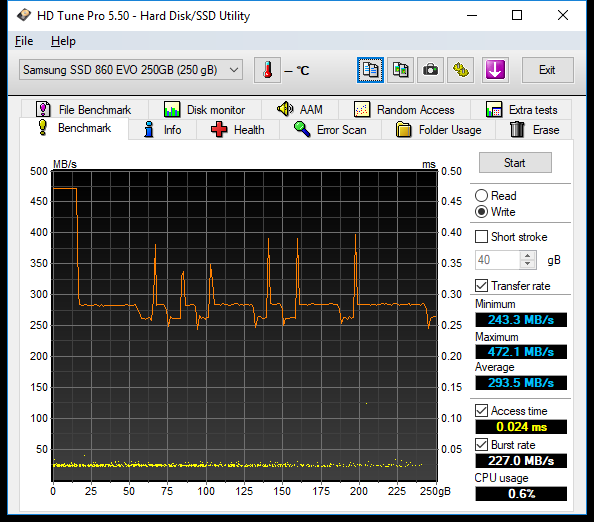
The TurboWrite area is smaller on the 250GB model. On the 500GB drive, we measured roughly 50GB of SLC capacity (~10% of the overall usable capacity). The 250GB 860 EVO only dedicates ~13GB of its capacity to SLC, which is 5%. The native TLC performance falls close to 250 MB/s, which is only slightly lower than the 500GB model we tested on the previous page.
Random Read Performance
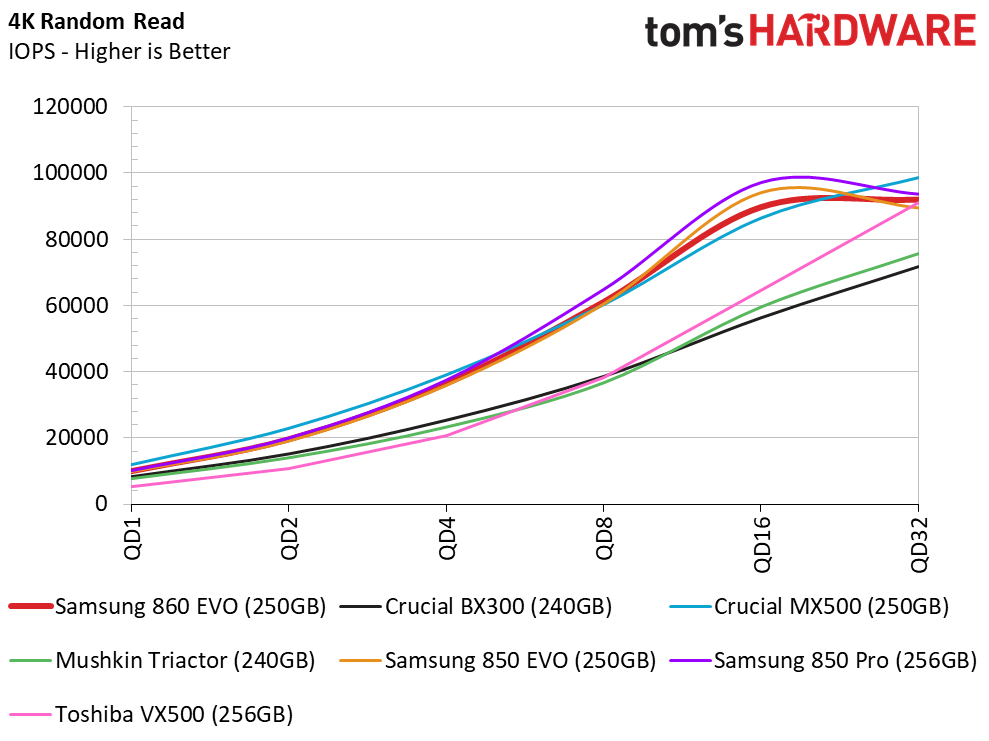
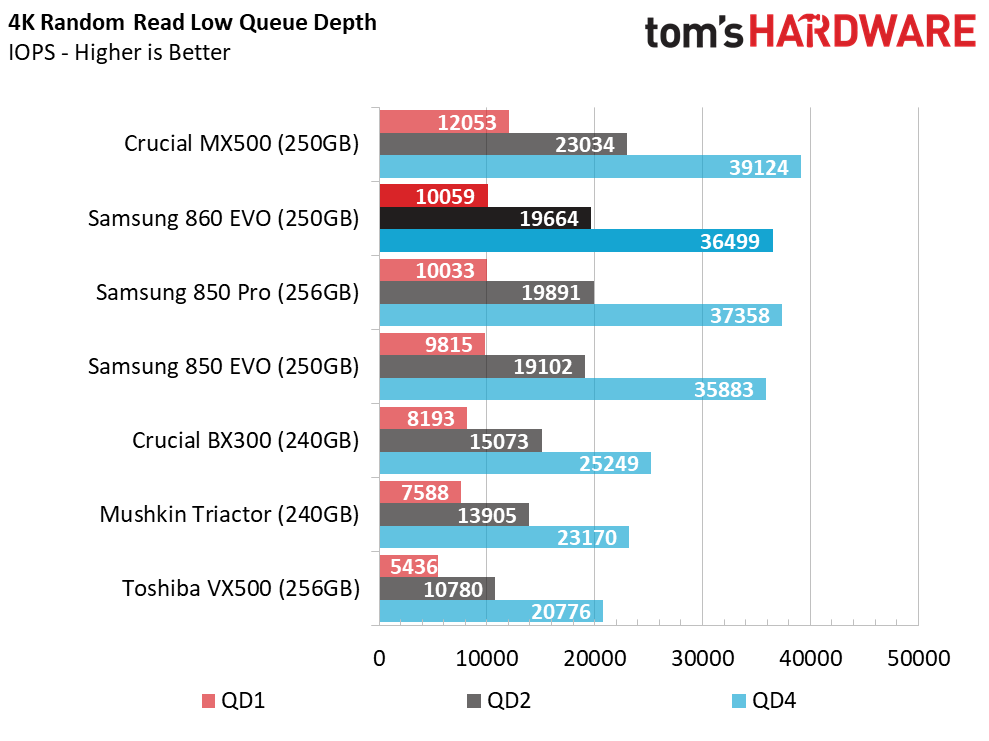
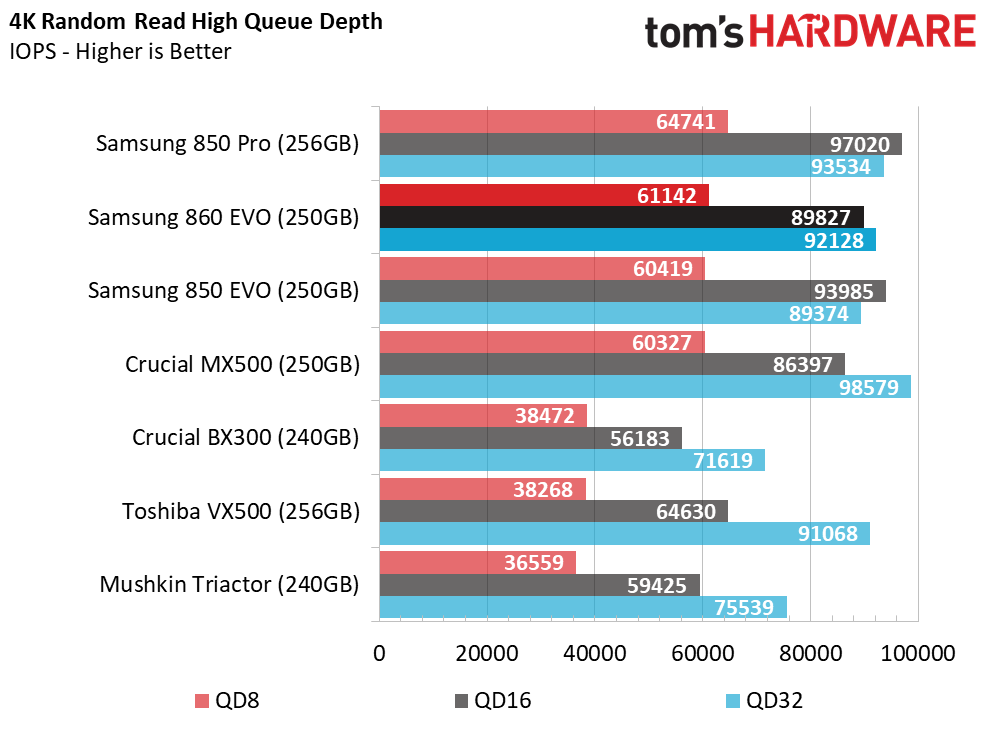
We see more separation in the 256GB-class. The random read test splits into two distinct product classes even though the same products performed similarly with larger models. The 250GB MX500 still delivers more random read performance than the 860 EVO at low queue depths.
Random Write Performance
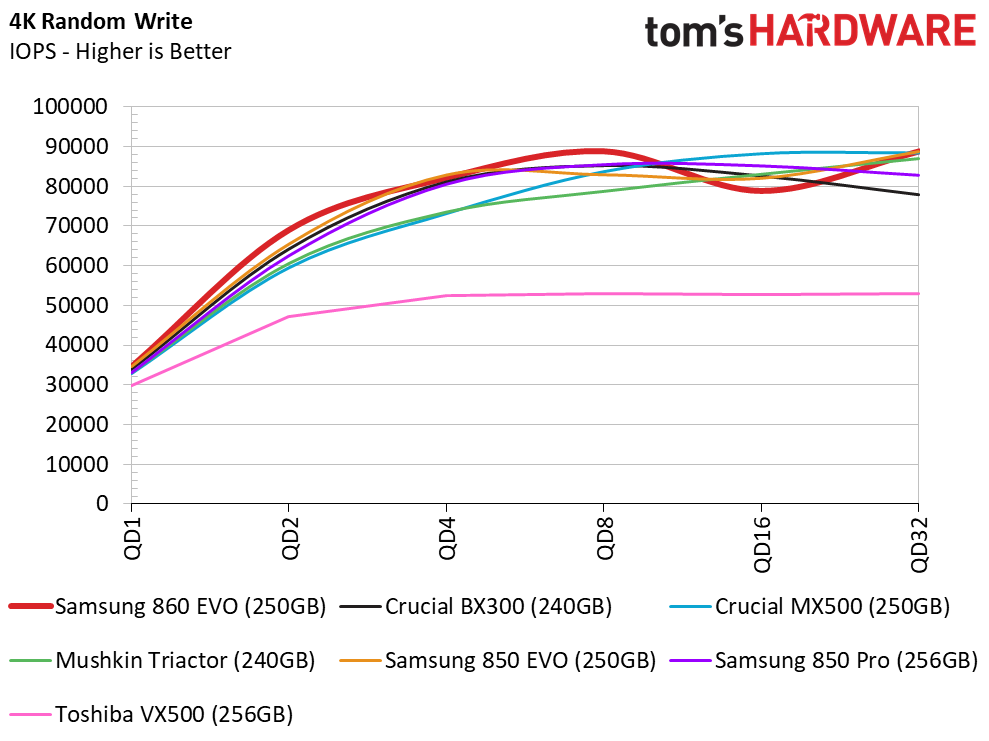
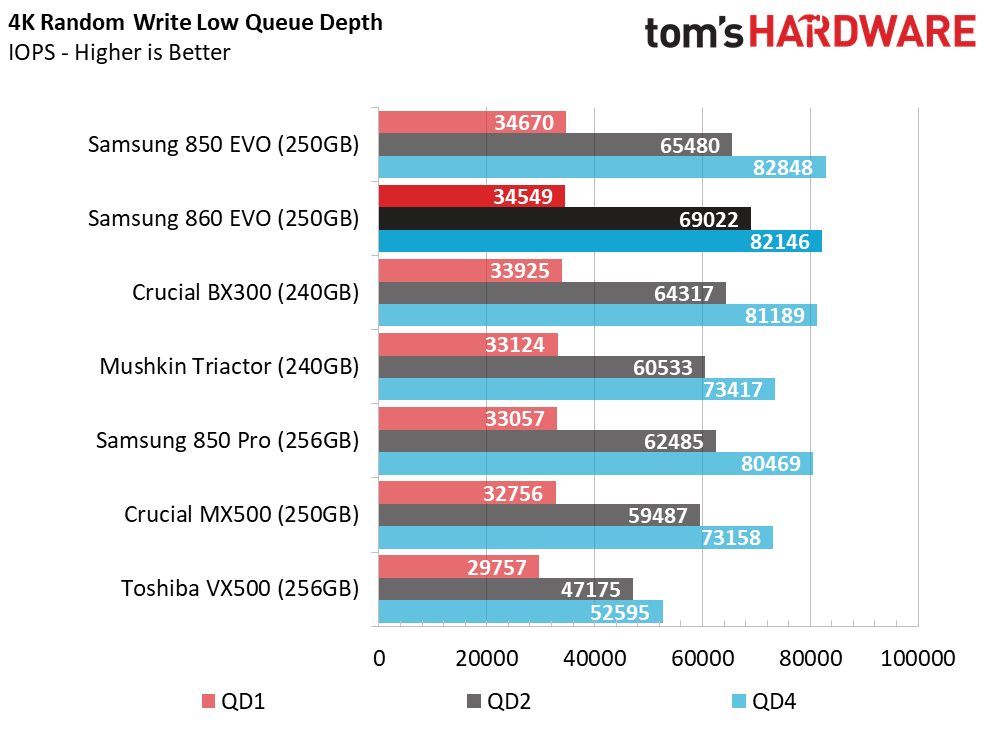
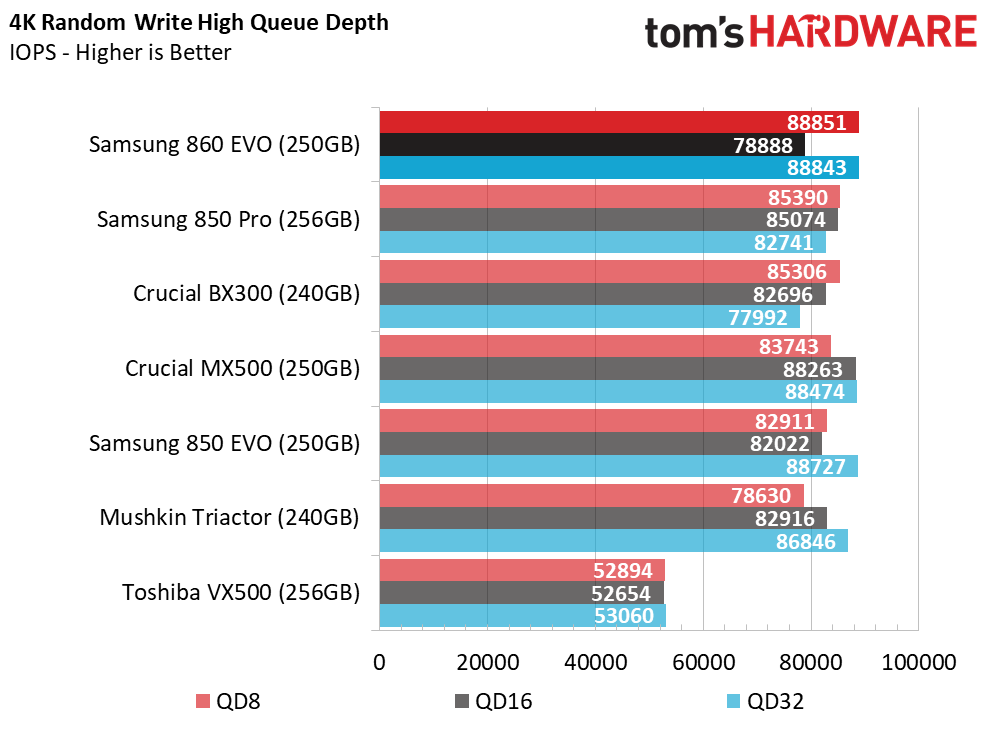
The new 860 EVO overtakes the older EVO at QD2, but it can't pass it at QD1. Both drives will offer similar performance in real-world use.
70% Mixed Sequential Workload
We describe our mixed workload testing in detail here and describe our steady state tests here.
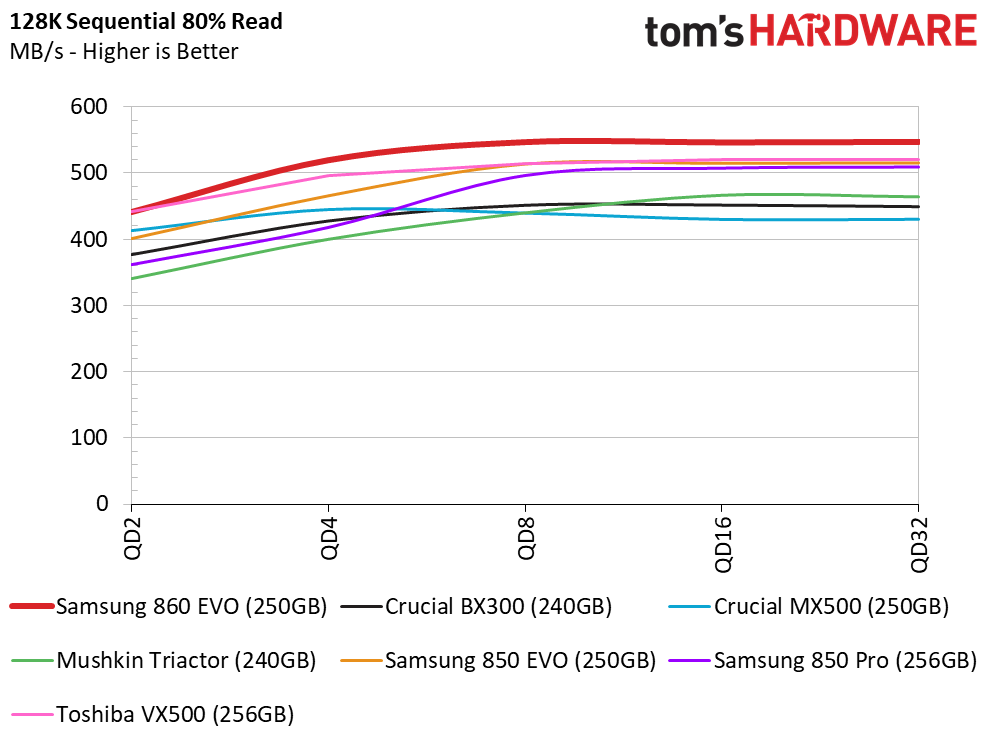
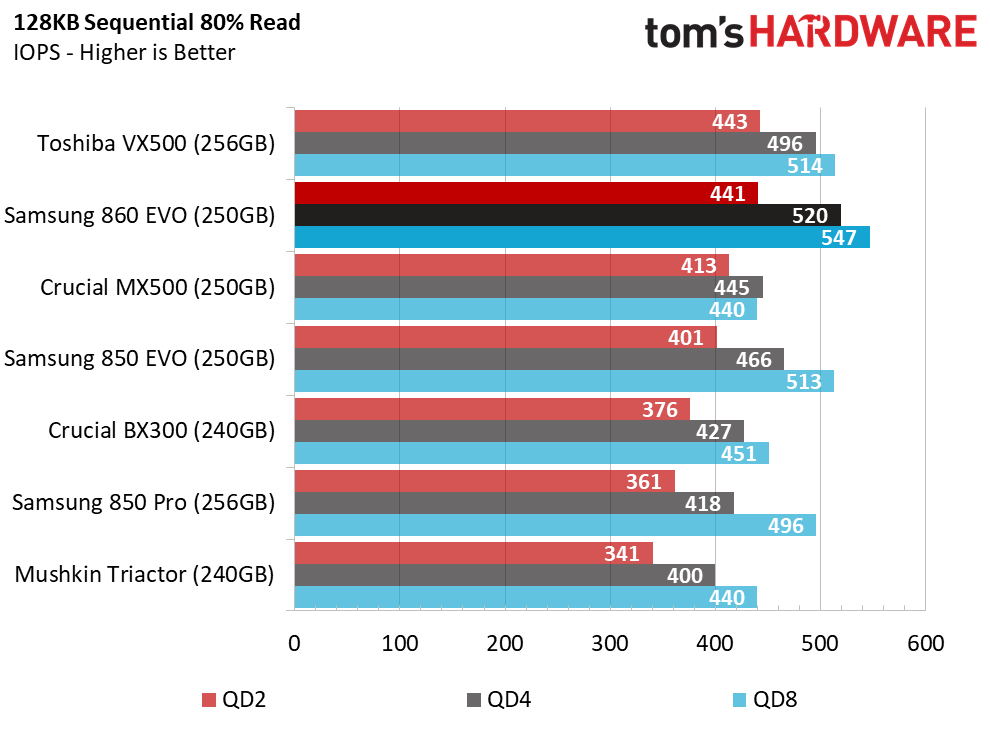
The newer 256GB-class SSDs perform well in the mixed workload, but the 860 EVO leads the heavier portions of the test.
70% Mixed Random Workload

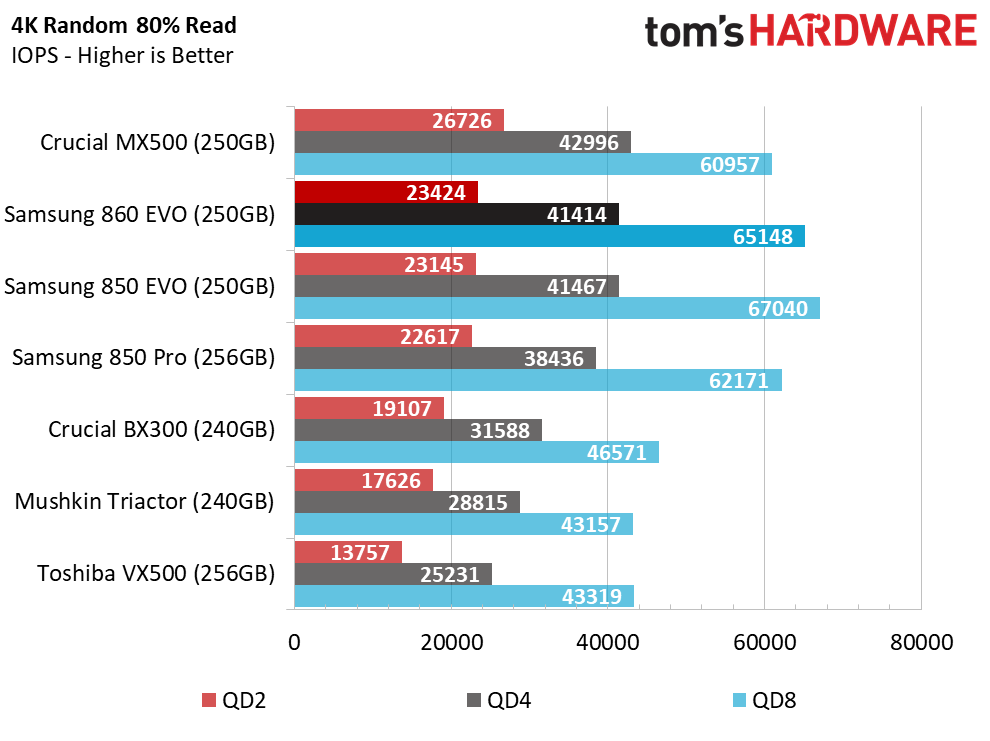
The 250GB MX500 is still competitive against the 860 EVO in this capacity. The pricing delta between the two is also much smaller with the 250GB models than we see with the larger models.
Sequential Steady-State

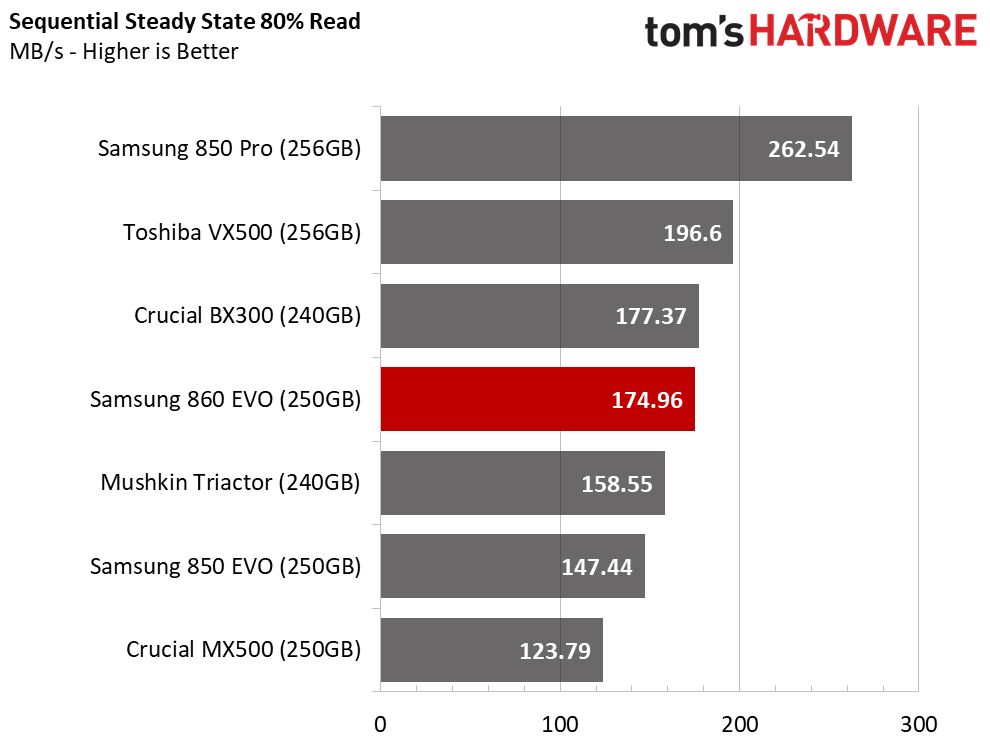

There is a larger gap between the low-capacity professional and consumer SSDs during this test. Steady-state performance in both sequential and random workloads is an important consideration for RAID performance.
Random Steady-State
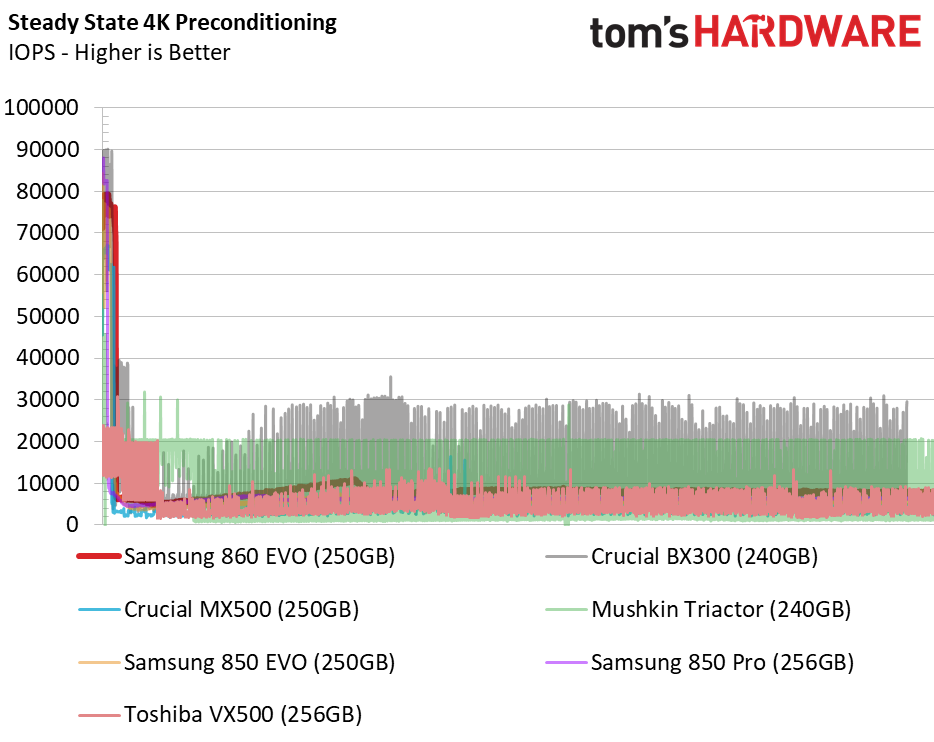
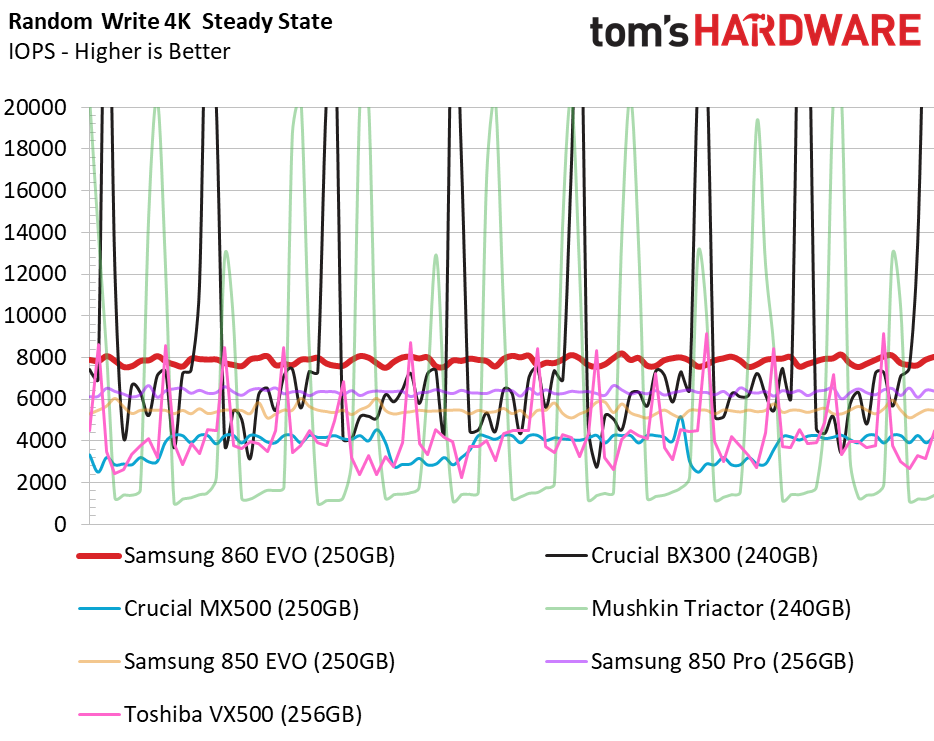
The 860 EVO unseats the 850 Pro and delivers the highest performance in steady state. The 860 EVO 250GB is a good consumer SSD for RAID, but your workload matters.
In the previous test, we saw the 850 Pro 256GB deliver much higher performance in steady-state with most sequential mixtures. Many professional applications read and write data at the same time. For instance, video editing pulls in several streams from the drive, and you render the data back as a single file. Your read/write mixture changes depending on the number of source files you use.
For many years, SATA RAID with low capacity SSDs increased performance enough to shift the bottleneck to the CPU or GPU. SATA RAID has fallen by the wayside due to NVMe SSDs, though SATA is still useful for a low-cost redundant array on a dedicated RAID controller. In that environment, you are better served by professional SSDs that work better in the less common workload mixtures.
PCMark 8 Real-World Software Performance
For details on our real-world software performance testing, please click here.
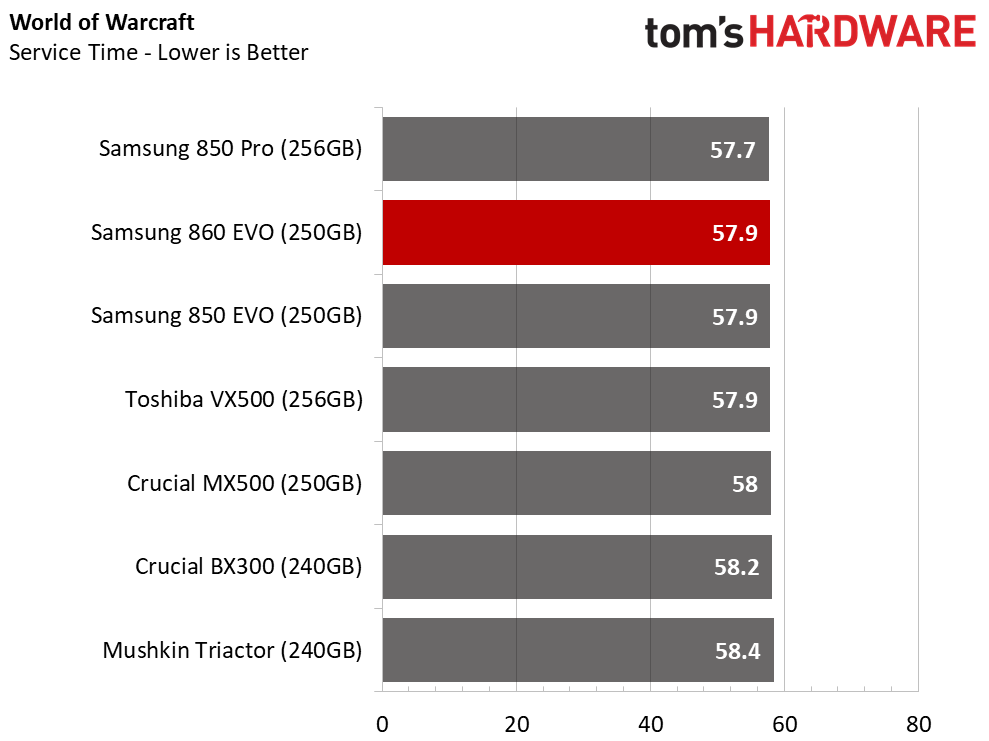
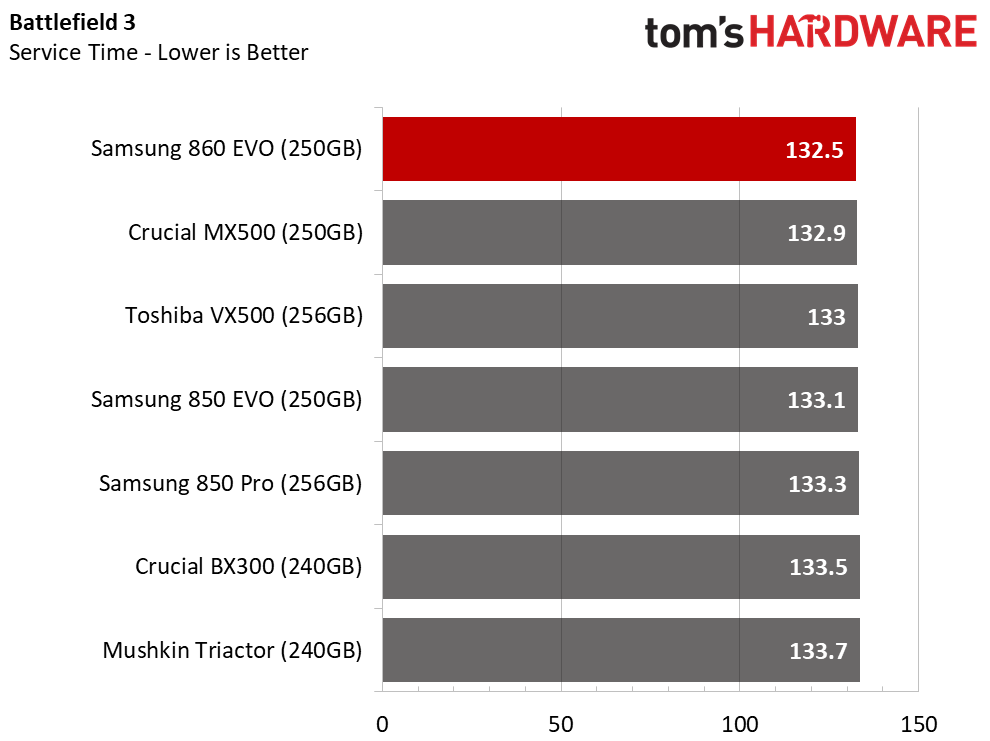
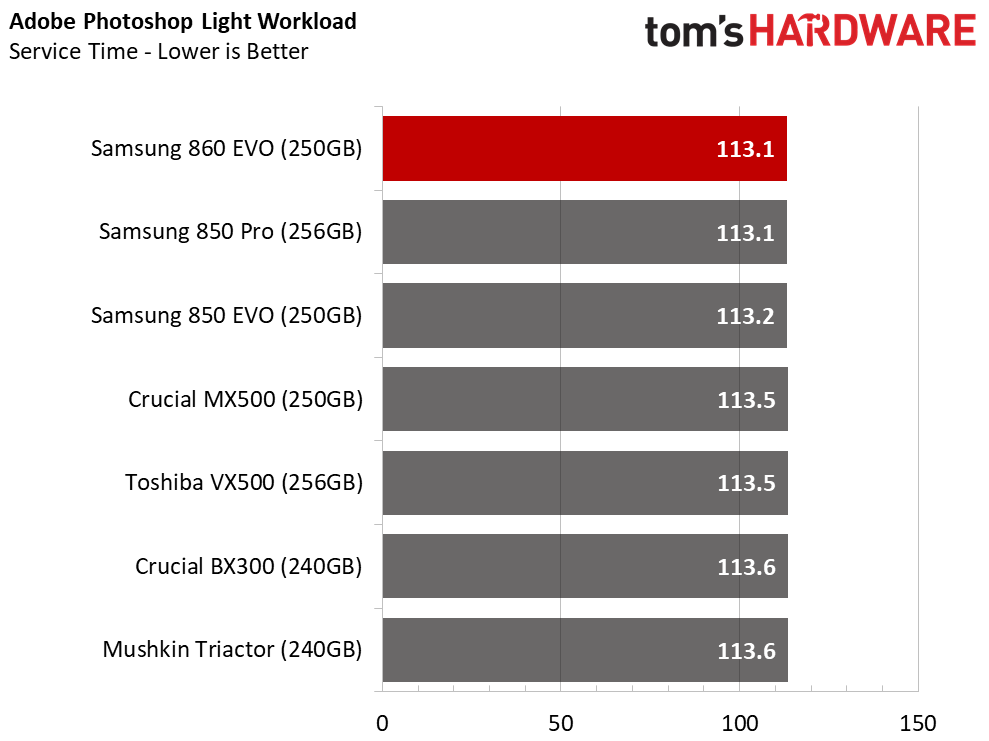
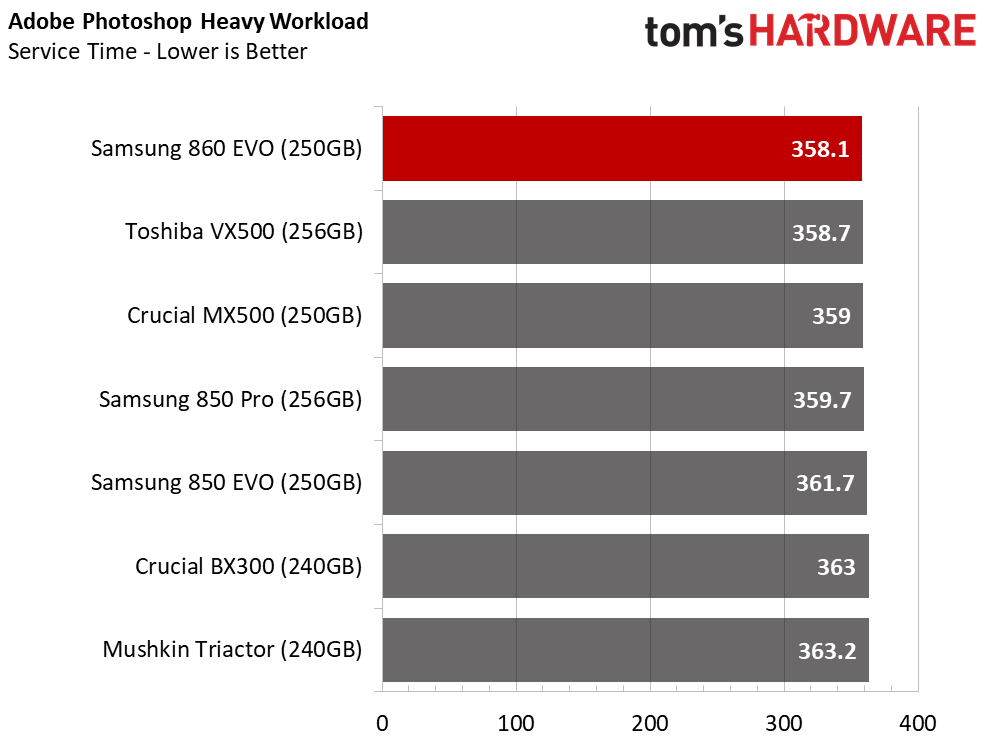
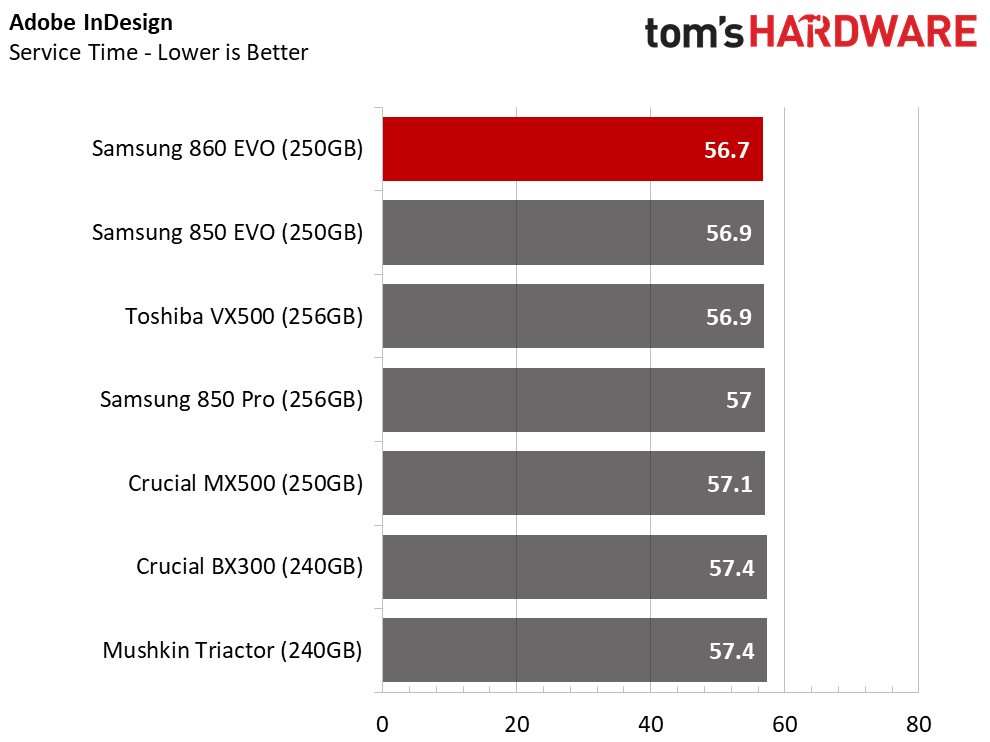
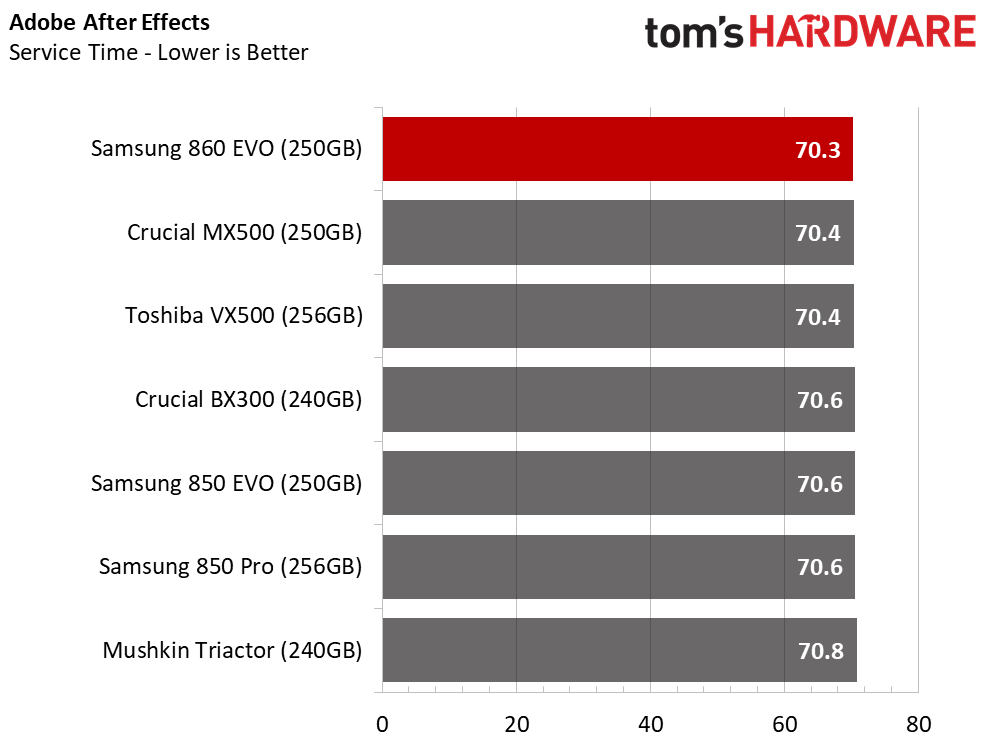
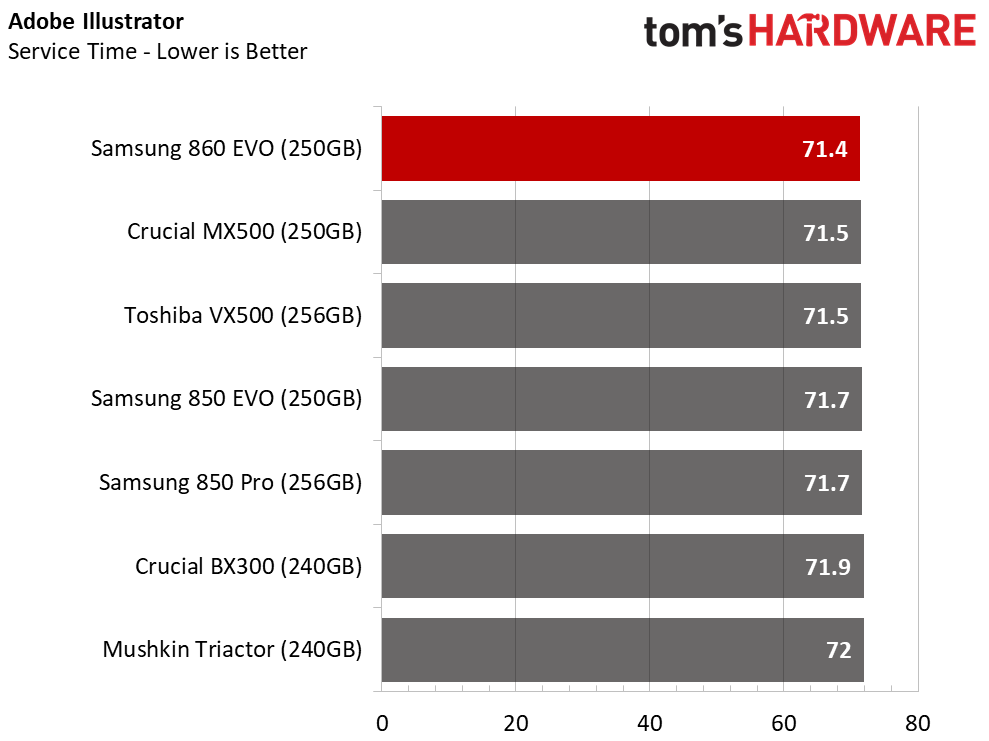


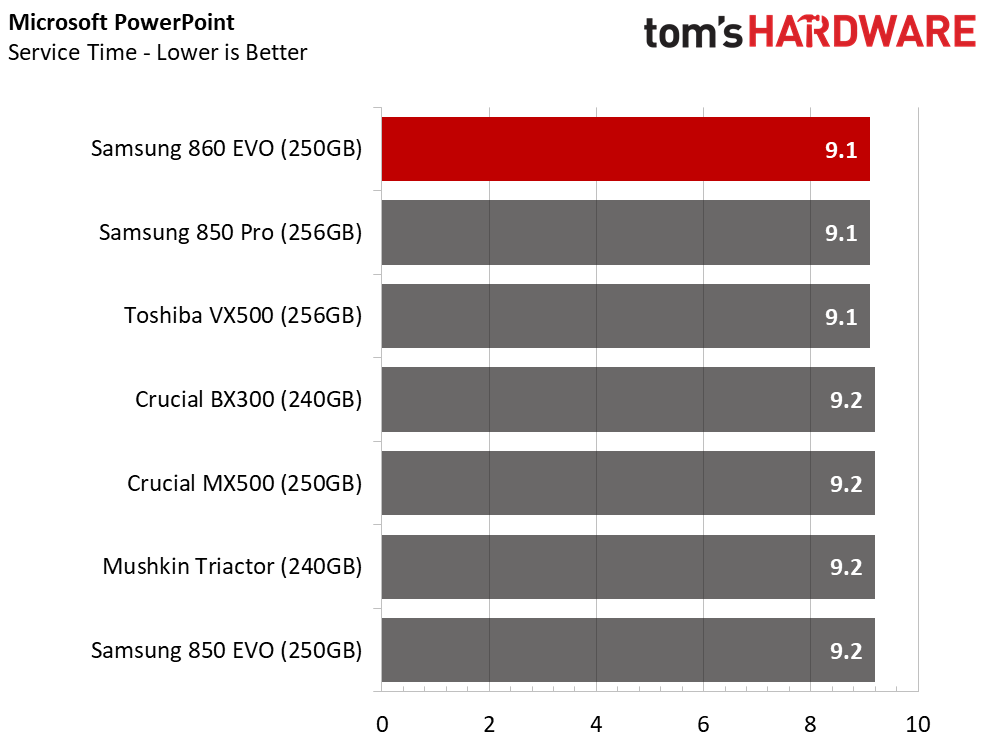
The 250GB 860 EVO smashes through the consumer application workloads and wins top honors in nearly every single test.
Application Storage Bandwidth
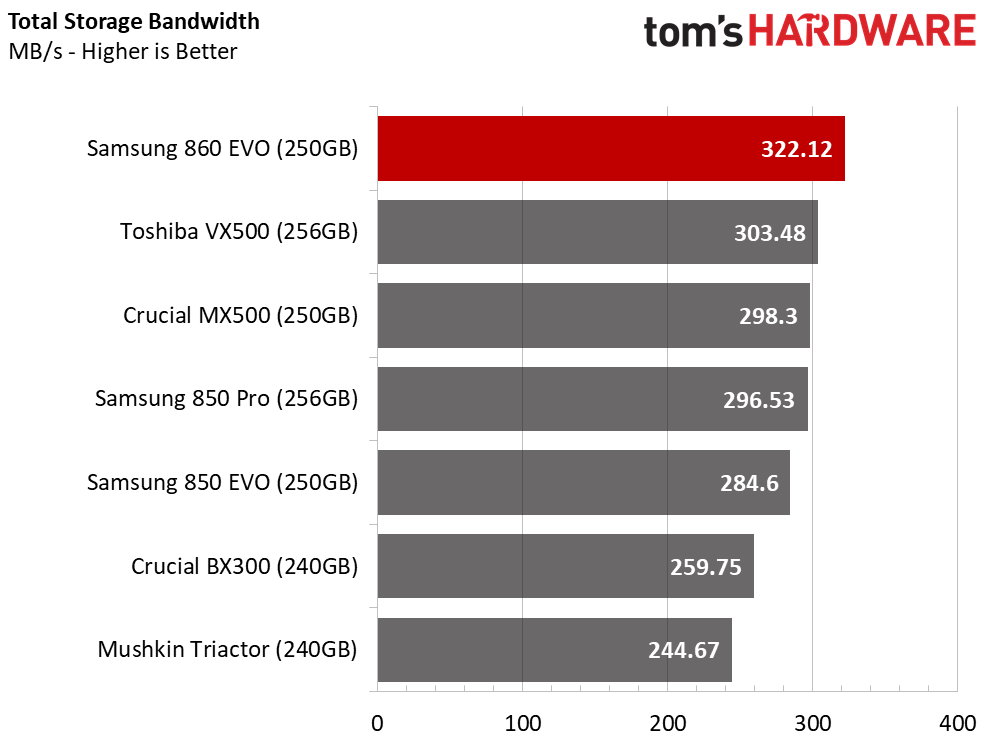
The 860 EVO is the clear winner with a 19 MB/s lead over the Toshiba VX500 and a larger lead over the MX500. That said, you are not going to see a lot of difference between these drives unless you push them with much more stringent workloads.
PCMark 8 Advanced Workload Performance
To learn how we test advanced workload performance, please click here.
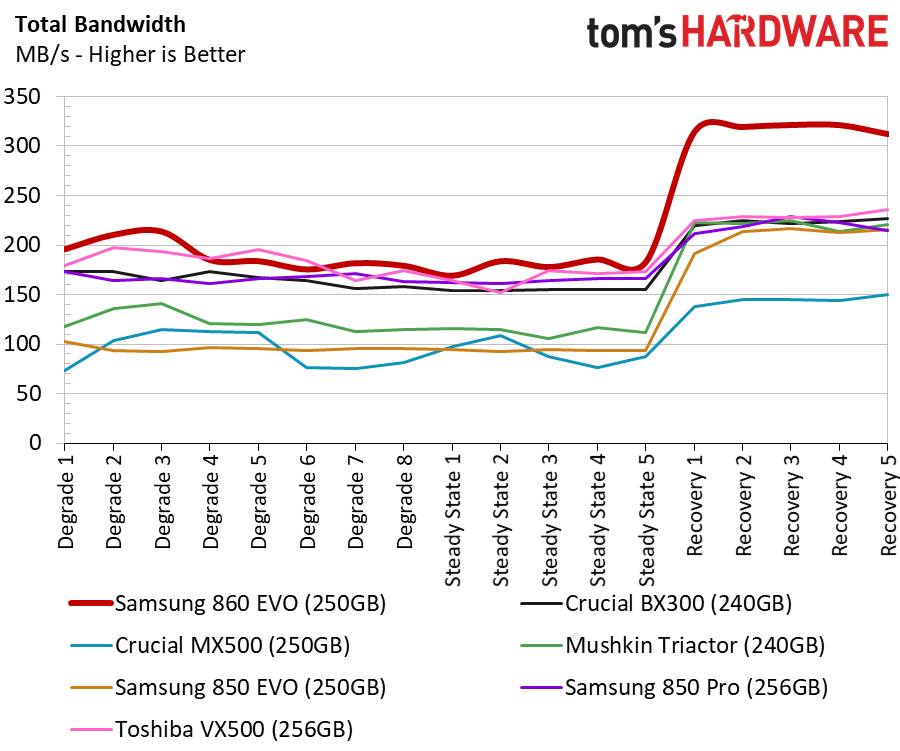
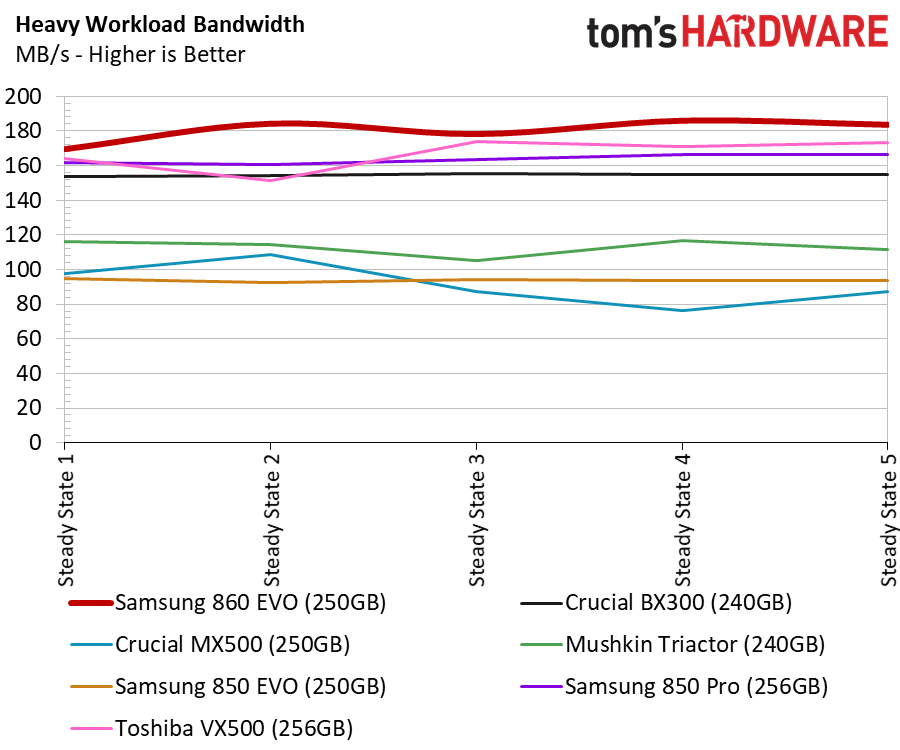
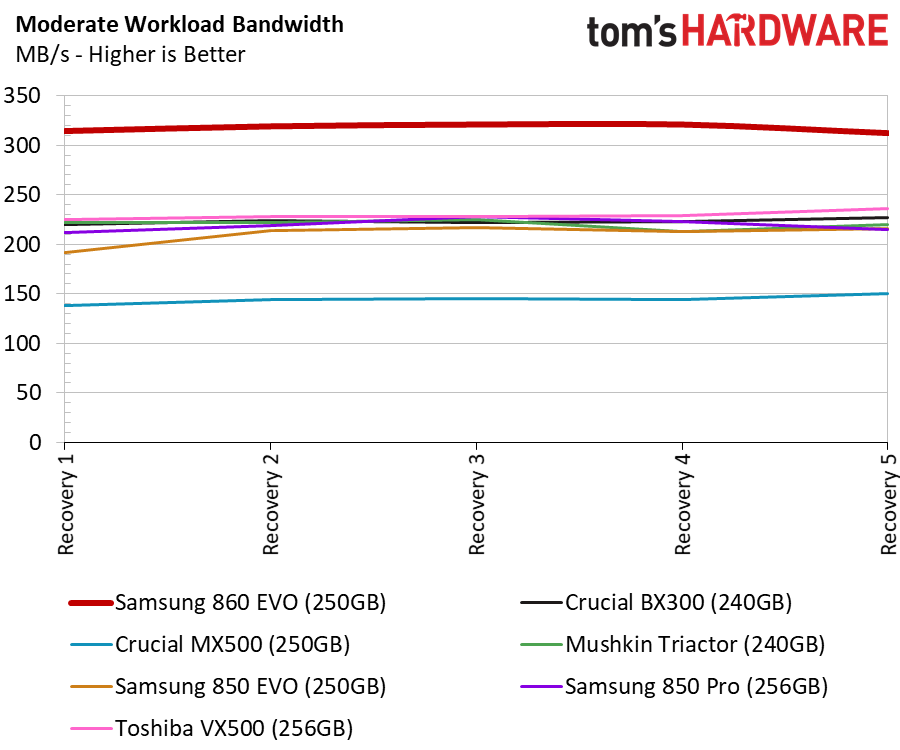
The 860 EVO recovers very well and returns to full performance after very little idle time. The other drives also recover, but not as fast. The other drives would perform better after a longer idle period.
Total Service Time



Samsung has always had a very aggressive garbage collection system on the lower capacity models. In some products that can actually result in reduced performance because background activity consumes clock cycles and increases latency. Samsung improved the design by adding a third core dedicated to background operations. The company hasn't disclosed any details about the new MJX controller, but we suspect it uses a five-core design like the controller in the 960 series.
Disk Busy Time
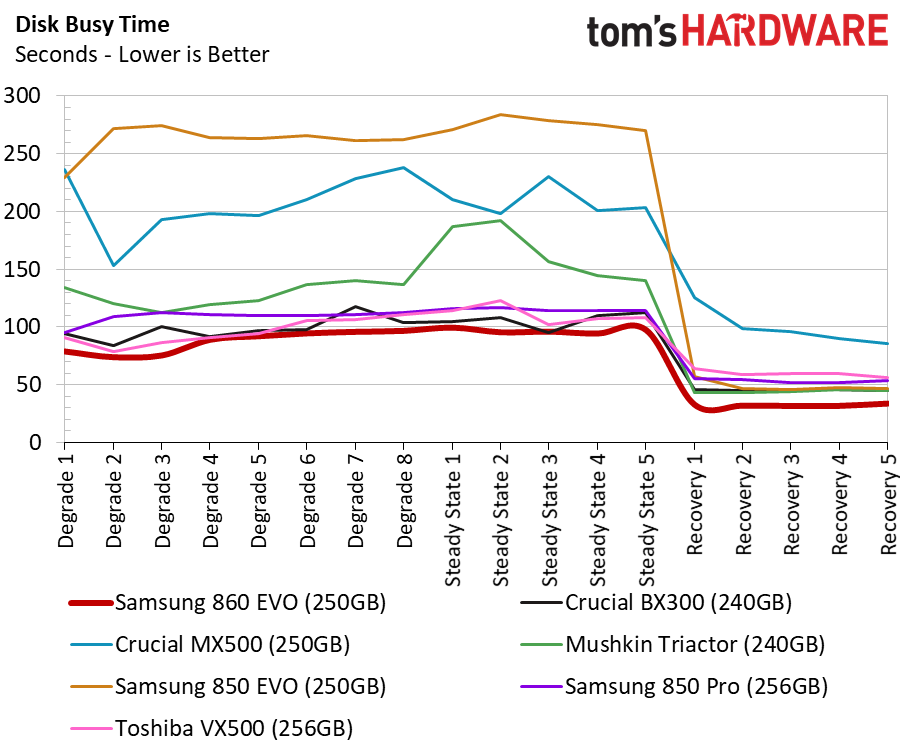
The 860 EVO is the drive to get if you need a small drive that can handle heavy write workloads. It works less than the other drives to complete the workloads. Unfortunately, the operating system adds so much latency that the end results are much closer together in Windows. The 860 EVO finishes the programed workload faster and then returns to an idle state.
BAPCo SYSmark 2014 SE Responsiveness Test
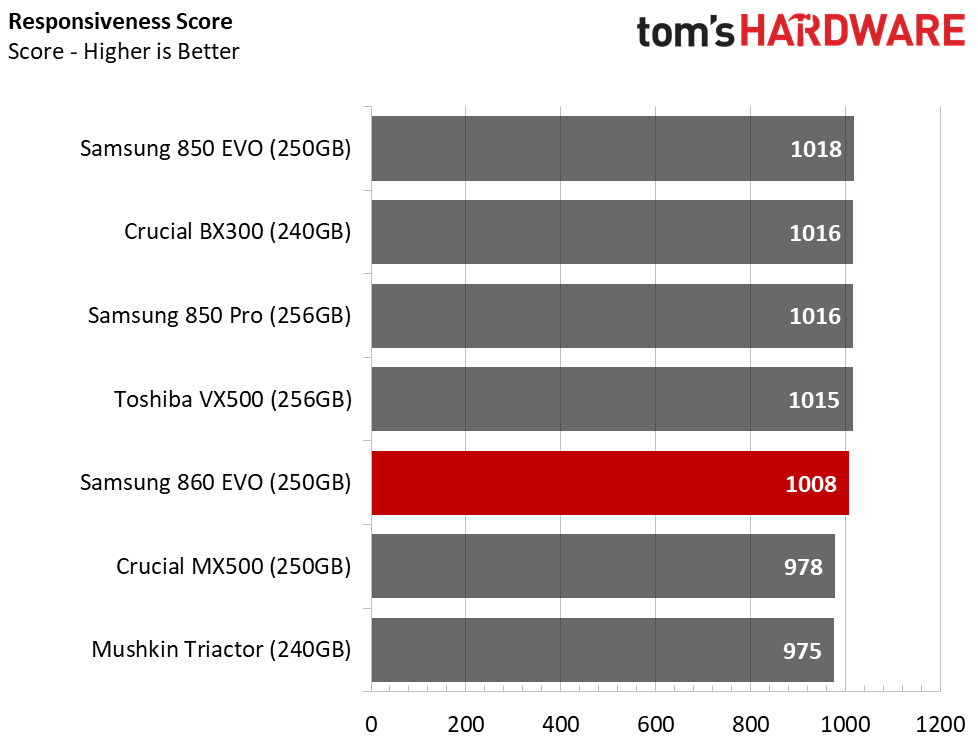
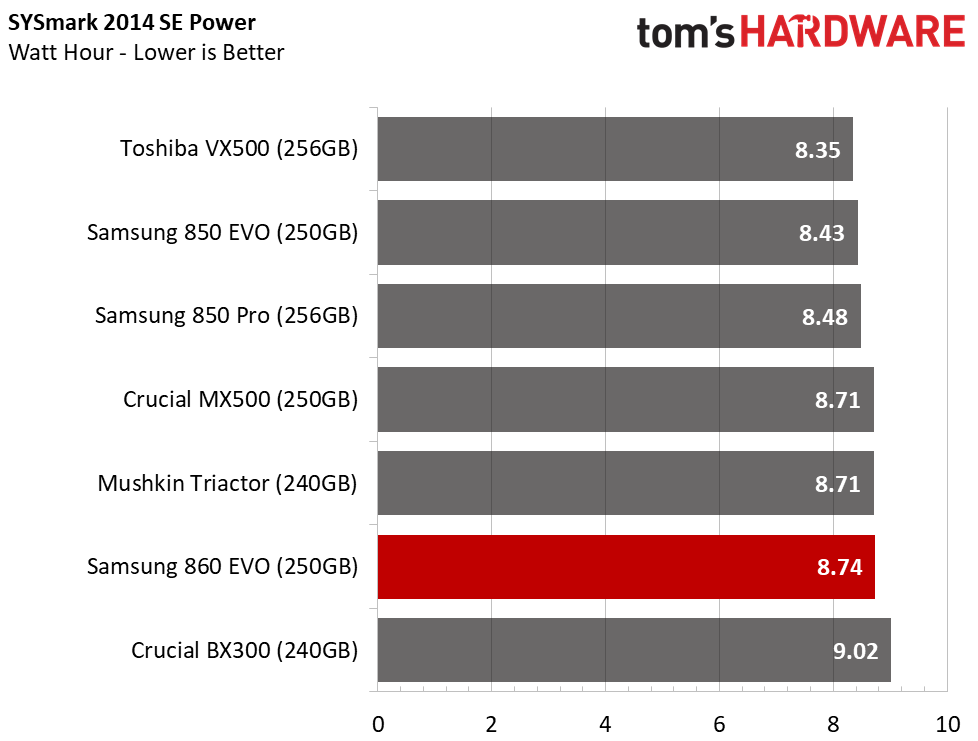
As expected, the responsiveness score continues to decline as we shave off capacity. The drive still delivers over the 1000 points in the test. Anything over that mark provides a good user experience.
BAPCo MobileMark 2012.5 Notebook Battery Life
To learn how we test advanced workload performance, please click here.
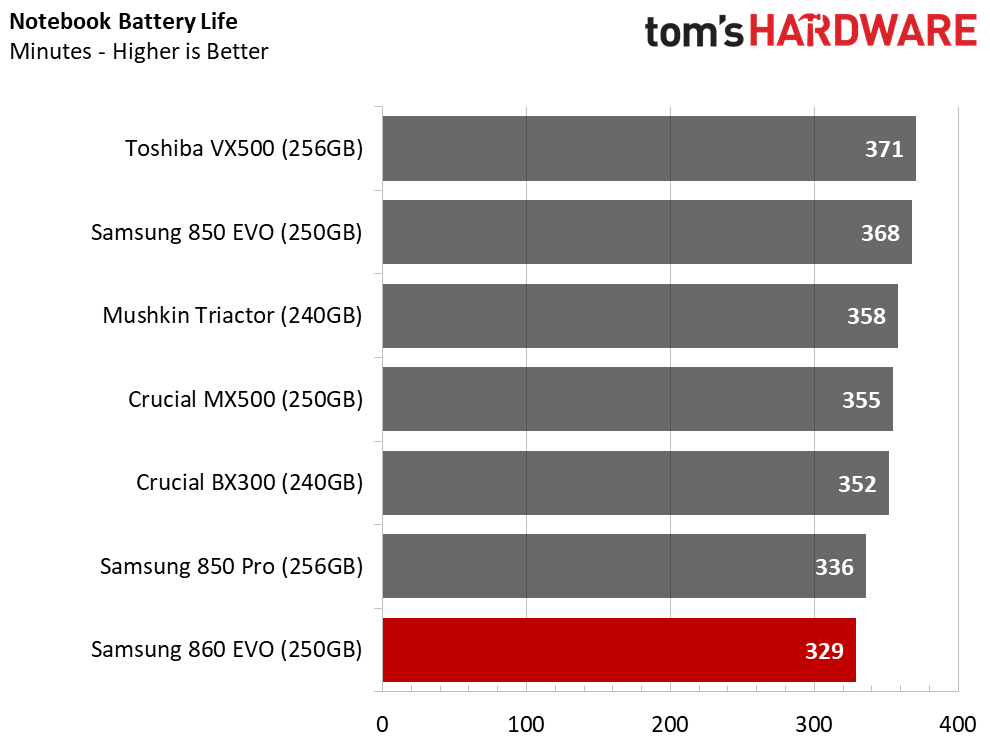
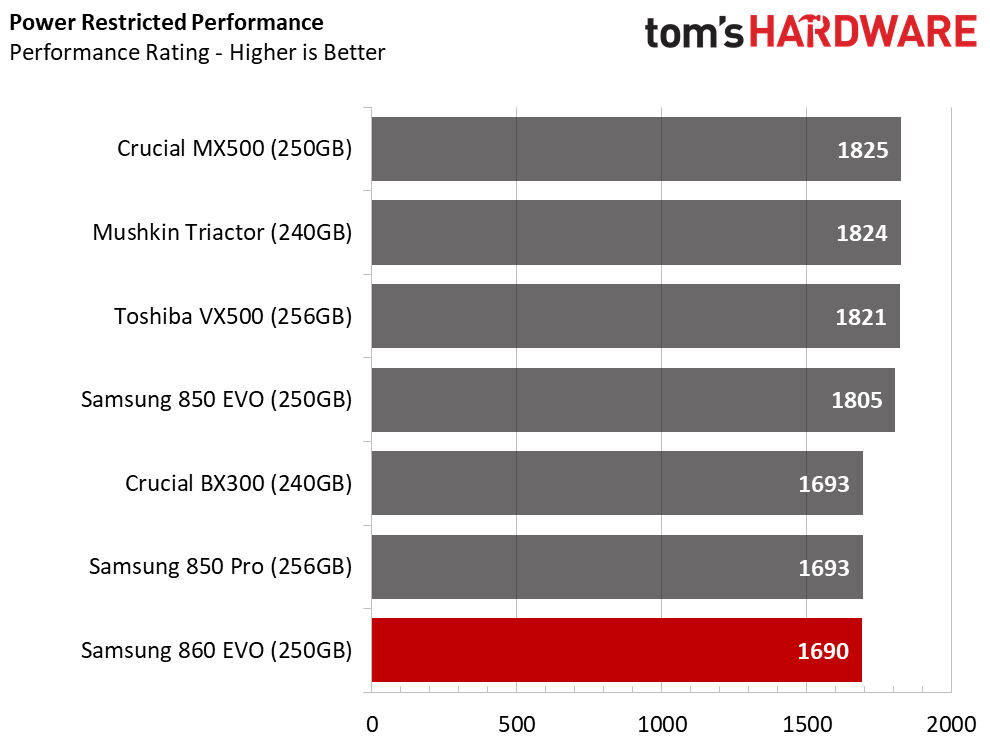
Like the two high-capacity models, the smaller 860 EVO suffers from poor laptop battery life. We observed the same issue with the 860 Pro, so it's baked into the firmware. We rarely talk about the manufacturer's power ratings because they don't carry over as you would expect. The Samsung 860 series should deliver strong performance in this test, but that isn't what we found in our testing.
MORE: Best SSDs
MORE: How We Test HDDs And SSDs
MORE: All SSD Content
Stay On the Cutting Edge: Get the Tom's Hardware Newsletter
Get Tom's Hardware's best news and in-depth reviews, straight to your inbox.
-
logainofhades I think I would rather have the better Price/GB of an MX300. MX300 has more storage and is cheaper. The 960 evo isn't much more either really, at the 250gb level anyway.Reply
PCPartPicker part list / Price breakdown by merchant
Storage: Samsung - 960 EVO 250GB M.2-2280 Solid State Drive ($118.99 @ SuperBiiz)
Storage: Samsung - 860 Evo 250GB M.2-2280 Solid State Drive ($94.99 @ Amazon)
Storage: Crucial - MX300 275GB M.2-2280 Solid State Drive ($89.89 @ OutletPC)
Total: $303.87
Prices include shipping, taxes, and discounts when availableGenerated by PCPartPicker 2018-02-08 16:21 EST-0500 -
AlistairAB So basically the MX500 is cheaper and even has better random read performance (the only metric i really pay attention to).Reply
Also Samsung doesn't provide warranty service in Canada properly, a caution to readers. (Search for horror stories about the 960 EVO warranty process in Canada at redflagdeals if you want more... basically they stonewall you requiring you to return to retailers, which is how it works in Europe, not in Canada).
Buy Crucial. -
Dark Lord of Tech Sticking with my Samsung 960 EVO Series 1TB too , crazy fast , but the 860 is another solid release from Samsung , best on the market in terms of reliability.Reply -
Martell1977 So it seems that this is a 850 EVO but with higher bandwidth and warranty. I'm glad to see that my 850 EVO 500gb is still one of the best. Seems that performance for these drives has been stagnate for a while now.Reply -
Radar_1 If I decide to head to the store and purchase a new SSD, the 850 EVO appears to still be the best bang for your dollar.Reply -
JonDol "The 860 EVO has half the endurance of the new 860 Pro, but it's still quite a bit more than competing products. It's a good argument, but who really cares?" Well, I do. For that reason I only buy the Pro ones and I'd buy the EVOs above all the others if the Pro weren't available.Reply
About the title: I wasn't even aware that Samsung had lost the leading spot :-)
